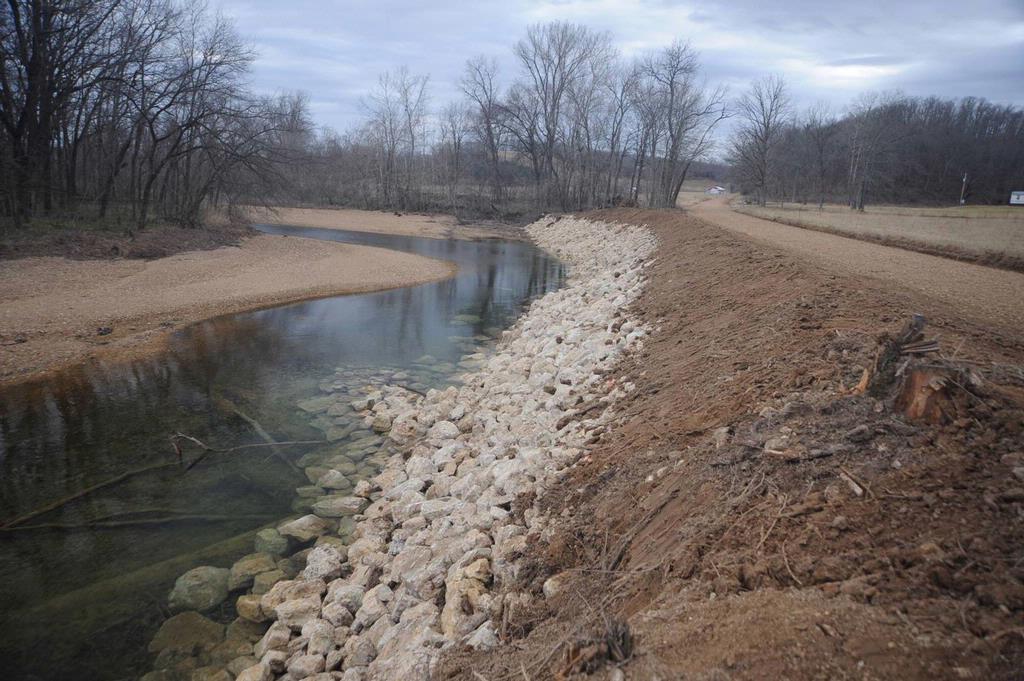Stone Toe Protection

Definition
This technique secures the lower portion of a streambank so that an entire bank becomes stabilized over time. With stone toe protection, a row of stone is placed at the toe of an eroding bank, parallel to the stream. The "toe" lies at the bottom of the slope and supports the weight of the bank. The result is that, in time, a stable slope is created by the deposition of sediments behind the row of stones. The upper bank, above the stone toe protection, does not remain vertical but gradually slumps to a stable slope.
A row of stone is placed at the toe of an eroding bank, parallel to the stream Applicability: This technique is useful where an upper bank is being undercut near the base of the bank on gentle to moderately severe bends in the channel. It works well on small or mid-size streams. The stone toe method also integrates well with other low-cost streambank-protection methods such as live stakes, vanes or wing deflectors.
Effectiveness
An erosion-control plan on the land upstream from the stabilized streambank is necessary.
Pasture and timber areas on steep slopes should be managed for adequate vegetative cover to slow water runoff. Also, the toe of slope must be installed at an elevation that allows flood- water to overflow onto the floodplain to maintain or restore natural channel dimensions. Fields adjacent to a stream should be protected with a wide riparian border.
Costs
Stone toe protection costs can vary, depending upon the availability of suitable stone close to the project site. Frazee (2000) estimates installation costs between $17 to $28 per foot, while MDE (2000) cites an average cost of $67 per foot. (Note: Cost estimates adjusted to 2005 U.S. dollars.)
Maintenance
Maintenance requirements vary depending on the characteristics of the stream system including velocity, flood frequency, flood stage, timing and sediment load. Generally, stone toe protection requires very little maintenance including replacement of rocks removed by extreme flows.
Design Considerations
- May be used on streams where banks are being undermined by toe scour, and where vegetation cannot be used.
- Stone prevents the removal of the failed streambank material that collects at the toe, allows revegetation and stabilizes the stream bank.
- Should be used with soil bioengineering systems and vegetative plantings to stabilize the upper bank and ensure a regenerated source of streamside vegetation.
- Can be placed with minimal disturbance to existing slope, habitat, and vegetation. Must be carefully installed at proper elevation with regard to bankfull elevation.
References
MDE. 2000. Maryland’s Waterway Construction Guidelines. The Maryland Department of the Environment Water Management Administration,
http://www.mde.state.md.us/wetlands/guide.html
Frazee, B. 2000. Stone Toe Method Gaining Ground as Low-Cost Way to Stabilize Streambanks.
http://www.aces.uiuc.edu/index.shtml
Shields, Jr. F.D., Knight, S.S., and Cooper, C.M. 1995. "Streambank Protection and Habitat Restoration". Volume 1 of the ASCE conference, The First International Conference on Water Resources Engineering, San Antonio, TX. p. 721- 725
FISRWG. 1998. Stream Corridor Restoration: Principles, Processes, and Practices. Federal Interagency Stream Restoration Working Group,
http://www.usda.gov/wps/portal/usdahome
Recommended Fact Sheets and Resources
FISRWG. 1998. Stream Corridor Restoration: Principles, Processes, and Practices. Federal Interagency Stream Restoration Working Group,
http://www.usda.gov/wps/portal/usdahome